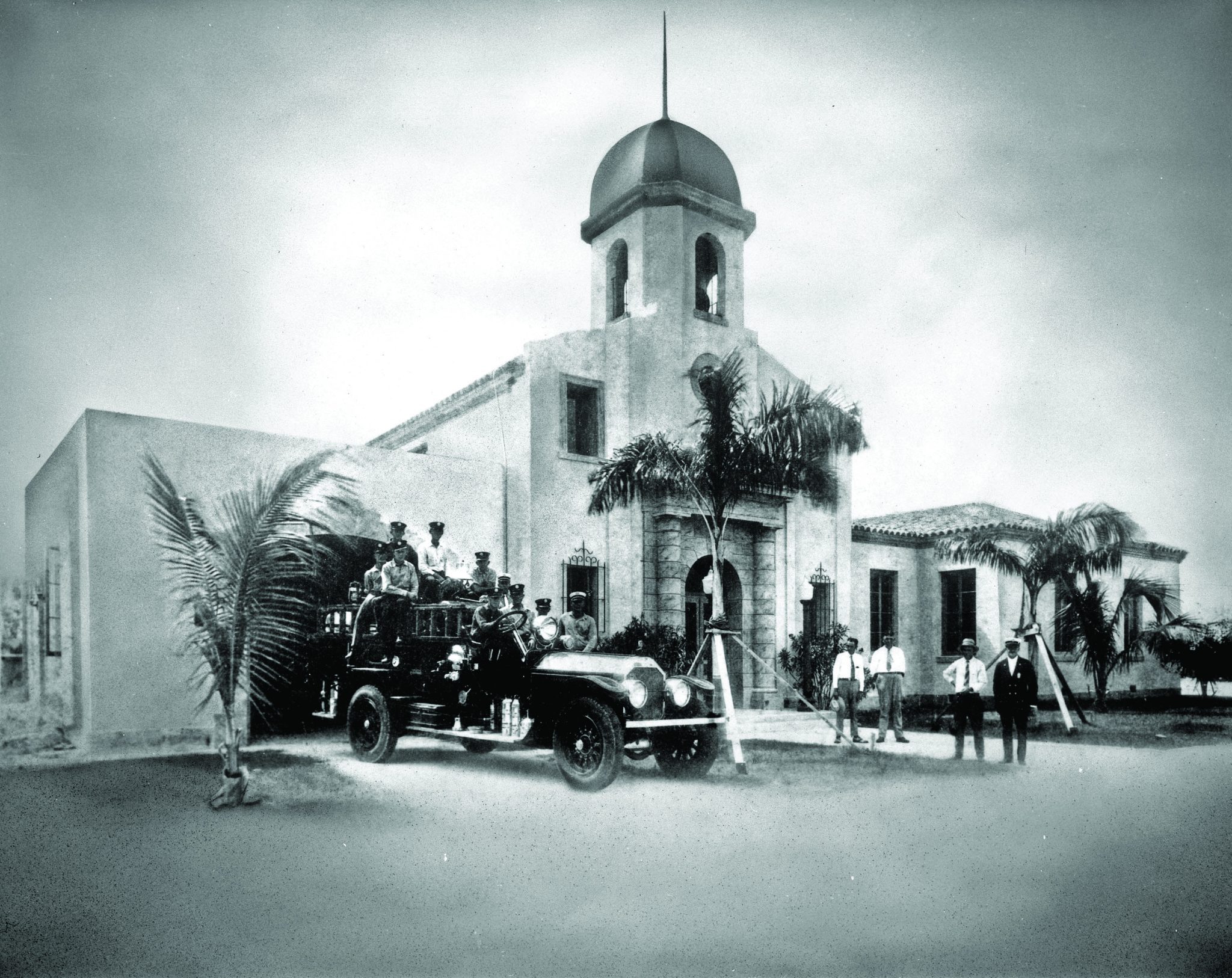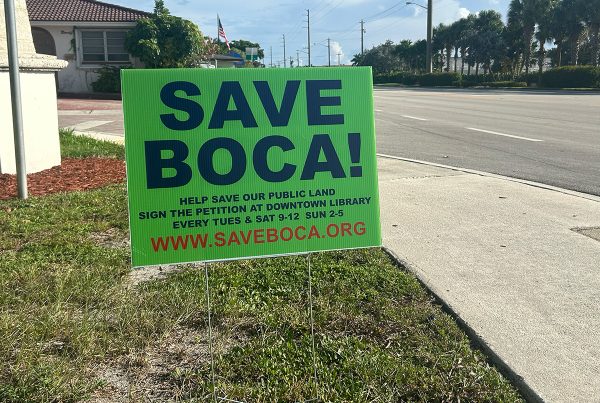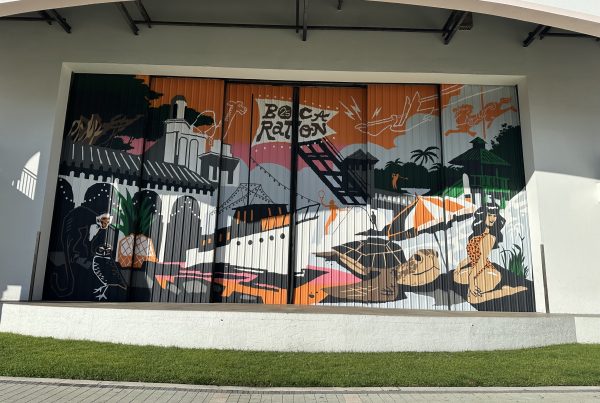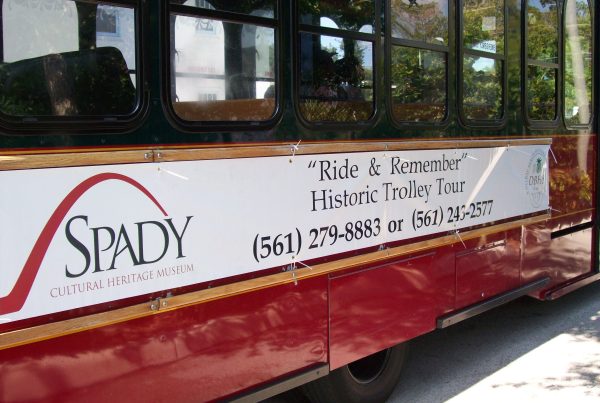As you drive or stroll around today’s downtown Boca Raton, it’s hard to imagine there is anything left of the once small town with a population of only 7,000 residents in 1960. But indeed, there are a few holdouts—if you know where to look.
Boca Raton Road and the Palmetto Promenade
Boca Raton Road (not to be confused with Boca Raton Boulevard) is an east-west street that originally ran from Dixie Highway all the way to Northeast Fifth Avenue. It is one of our earliest named streets. Boca Raton Road east of today’s Sanborn Square served as the “downtown” shopping area starting in the late 1940s. (In the Boca Raton Historical Society’s collections, there is a photo of the street dated “1953” and labeled “Main Street.”)
Several of the older buildings remain today with new purposes. The Morris Block Building I, at 111 E. Boca Raton Road, is a one-story attachment to a two-story structure on the north side of the street. It was originally constructed in 1946 and was home to the post office until it moved into its new home on Northeast Second Avenue in 1960. Today it is the home of Chabad of East Boca. The building also housed J.C. Morris’s Grocery (later Dave Minnehan’s Grocery) and Roadman’s Department Store. To the east stands 115 E. Boca Raton Road—Morris Block Building II. This three-bay building built ca. 1948 was home to an appliance store and Frank’s Sundry store—another Frank Roadman business.



On the south side of the street is 110 E. Boca Raton Road, another multi-bay structure constructed in 1948. It was home to a variety and appliance store in the 1950s; in 1960 Roadman’s Department Store moved there. The Tucci’s Pizza building at 50 N.E. First Avenue was the “Helpy Selfy” coin laundry in the 1950s. 101 E. Palmetto Park Road to the south is another two-story structure constructed by local contractor Louis Zimmerman for mixed use in 1945. Many of the adjacent structures on both East Boca Raton Road and East Palmetto Park Road were built in the 1950s and 1960s.
These businesses looked very different back in the day. They all reflected the dominant South Florida streamline modern style so popular in the mid-20th century. They featured details like flat roofs, glass blocks, and metal louvered windows in those days before air conditioning. All of these structures were “Mediterraneanized” many years ago in an attempt to conform with the city’s “Mizner style” design standards of the 1980s and beyond. Unfortunately, the buildings on the “south side” will be gone soon, replaced by the new Aletto Square building.
Federal Highway


Federal Highway is so named because it was built with “federal aid” back in 1927. It took until the 1930s to complete the highway through to Miami. Dixie Highway (1915) remained the most important north-south route until Federal was widened in the late 1940s. It is especially hard to believe there is any “old” left on Federal near Palmetto Park Road. However, a few “old timers” are still hanging on.
The L-shaped strip mall which is home to Yokohama Sushi and others at the northeast corner of Federal and East Palmetto Park Road dates originally from 1949. It was home to Boca Raton Sundries and Luncheonette and other businesses back in the day. The prosaic structure got a major Mediterranean overhaul in about 1985 and a new name— “Old Towne Shoppes,” in homage to Old Town Hall, across the street.


60 South Federal today houses Oriental Warehouse, an extensive collection of Asian decorative items and furniture. It started life as another Zimmerman building in 1936. The west facade (front) is a two-story, while the back or east side actually has an arched roof like a Quonset hut. Today, this is only visible from above—or “satellite view.” The building was home to Pennell’s Garage for many years and later the “Real Estate Corner” and then Boca Marine. Its “gas station” architecture now boasts fancy tile roofs and overhangs and multiple cupolas. Only a good detective would recognize it.
Directly across the street at 59 South Federal is a really old building—now home to the Elegant Child and others. This was Zim’s Bar in the 1930s and ‘40s—one of only two such establishments in town. It was, needless to say, a very popular place during World War II, when the little town was overrun with thirsty G.I.s. The two-story element was originally at the northeast corner of Dixie Highway and Palmetto Park Road—behind the current bank building. There are photos showing the building owned by local residents Helen and Maurice Stokes from 1915. This building was moved to Federal Highway (not built until the late 1920s) in 1934. Then, in 1948, Federal was widened, and the building was moved west seven feet to accommodate the new lanes. This is one of the oldest buildings left in town.




Town Hall
The building at 71 North Federal is one of the city’s most recognizable landmarks: Boca Raton’s former city hall. In 1925, the newly incorporated town appointed famed architect Addison Mizner as city planner. One of his commissions was to design a “city hall” for Boca Raton. Mizner designed first a two-, then a one-story version; both proved too expensive, as the Florida land boom was quickly going bust.


However, foundations and partial walls were erected for the one-story version, when construction was halted for several months. Finally, the town engaged the services of Delray architect William Alsmeyer, who completed the Mission-style building that stands today based on Mizner’s original footprint in 1927. The “municipal building,” as it was known for many years, served as the center of government until 1964, when “new” city hall opened on West Palmetto Park Road. The old building at 71 North Federal became home to the planning department—a place to pull your permits, etc. When new city hall was extensively remodeled in the early 1980s, the old building was no longer needed.
The Boca Raton Historical Society, a nonprofit agency, took on the task of restoring the old building to her former glory, and became the long-term tenant of the city of Boca Raton. Today, visitors can view “Town Hall” when they visit the Schmidt Boca Raton History Museum.




Sanborn Square
Boca Raton’s “village square” is opposite Town Hall on Federal Highway. The site served as the local bus station during WWII. In 1955, Eleanor Sanborn donated the south side of the park to the city in honor of her late husband William Sanborn, a longtime Boca snowbird. In the center was a large Norfolk Island pine that stood as the city’s Christmas tree for many decades. The park became the focus of city celebrations and special events for many generations to come. By the 1980s, downtown was in decline, and the Boca Raton Community Redevelopment Agency was born to stimulate growth and bring new life to the area. One of the first projects was the expansion of the little park to the north, with the generous donation of four lots from Charles and Dorothy Schmidt. Boca Raton Road, which was then a through street from Dixie to Fifth Avenue, was vacated through the park at that time. The newly expanded park was dedicated in 1985.


East Palmetto Park Road
Palmetto Park Road was Boca Raton’s original “street” connecting the old F.E.C. railway depot (then at Palmetto and Dixie) with the Intracoastal. It was known as the “rock road to the Canal,” and was lined with residences and snowbird cottages. Once the bridge over the Intracoastal was completed in 1917, it became the boulevard to the beach, and slowly changed into a largely commercial thoroughfare. The newer residential developments there harken back to its early days, in a way.


Luff’s Fish House, at 390 E. Palmetto Park Road, is a popular restaurant that was once the home of Harriet and Theodore Luff, built in the early 1920s. This bungalow-style structure was constructed with “coral rock”—actually oolitic limestone—a popular South Florida material back in the day. Although once common, it is the only example of the style in Boca Raton. It wasn’t just a private residence: Many old-timers remember it as the Boca Watch Shoppe and home of the Junior League—and the original home of the Historical Society.


300 E. Palmetto Park Road is a small house at the intersection of Southeast Third Avenue. Today it houses a law office and has had commercial tenants for many years. However, it began life as one of the houses of “Spanish Village,” a Mizner Development Corporation project built by well-known developer Harry Vought for Addison Mizner in about 1925. There were 22 small two-bedroom houses built in Spanish Village for the Mizner project contractors and their families. They featured arched windows, tiled roofs and pecky cypress ceilings like their Old Floresta counterparts. In the 1930s, several of the houses were moved to new locations, including two to East Palmetto Park Road. Moving a house was much less costly and less of a hassle than it is today. The building features an overhang addition on the north façade, facing the street. The original house, however, appears to be intact, making a very rare structure indeed. Morada Bonita is the name of the building at 741 E. Palmetto Park Road, east of the Intracoastal bridge. This house was built in the early 1920s as a “spec house” for pioneer realtor Harley Gates in the popular Mediterranean Revival style. It has been beautifully restored and currently houses Royal Palm Properties, another wonderful example of adaptive use of an historic structure.
Our Historical Society

The Boca Raton Historical Society is a private nonprofit agency founded in 1972 with the mission to collect, preserve and share the history of Boca Raton, and act as an advocate for historic preservation in the community. The Society is headquartered in the newly renovated Schmidt Boca Raton History Museum in the historic Boca Raton Town Hall at 71 N. Federal Highway. Our History Alive! exhibits feature a complete Boca Raton historic timeline and galleries on the pioneer era, Addison Mizner and the land boom, WWII, and IBM Boca Raton. Our temporary exhibit galleries highlight various topics on local history.
Boca Raton Historical Society’s programs bring Florida’s history to the community in ways that are both educational and entertaining. In addition to programs for school-age children, the museum is well known for its popular lecture series, Town Hall Talks, and tours of The Boca Raton hotel, which we have been giving for almost 50 years. The BRHS research collections serve a wide variety of patrons as the principal archive for information on the history of the area. The museum’s website, bocahistory.org, is one of its best-used assets, providing a variety of resources on local history for students, teachers and the general public. Our special events include a popular concert series and the annual Boca Bacchanal, a celebration of wine and food.
The Schmidt Boca Raton History Museum is at 71 N. Federal Highway in Boca Raton and is open Wednesday-Saturday from 10 a.m. to 4 p.m. Admission is $12 for adults, $8 for seniors and students, and free for children under 5. Admission is free to BRHS members. For more information, visit bocahistory.org or call 561/395-6766.
This article is from the November/December issue of Boca magazine. For more like this, click here to subscribe to the magazine.







